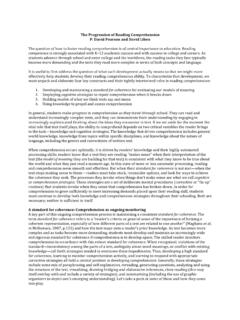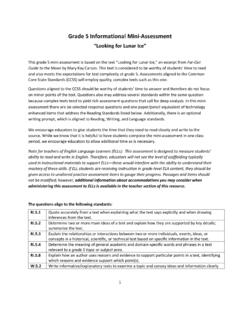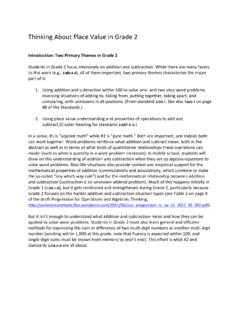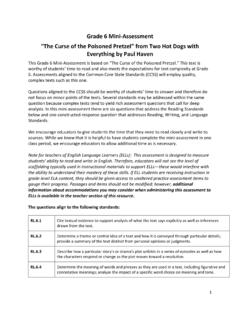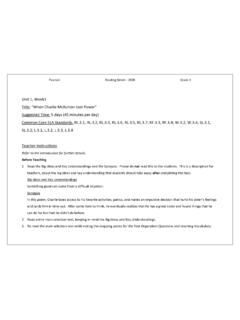Transcription of Foundations of Multiplication and Division
1 1 Foundations of Multiplication and Division Conceptual Understanding Mini-Assessment by Students Achievement Partners OVERVIEW This mini-assessment is designed to illustrate assessment of early progress in the domain. This mini-assessment is designed for teachers to use either in the classroom, for self-learning, or in professional development settings to: Evaluate students understanding of aspects of addressed early in the learning of Multiplication and Division in order to prepare to teach this material or to check for student understanding, and to check for student progress toward fluency; Gain knowledge about assessing some of the conceptual understanding, procedural skills, fluencies, and applications of Multiplication and Division ; Illustrate CCR-aligned assessment problems.
2 Illustrate best practices for writing tasks that allow access for all learners; and Support mathematical language acquisition by offering specific guidance. MAKING THE SHIFTS This mini-assessment attends to focus as it addresses the earliest understandings of Multiplication and Division , which are at the heart of the grade 3 standards and a key component of the Major Work of the This mini-assessment addresses only some of the third-grade expectations for Multiplication and Division . Later in grade 3, students will use this foundational understanding of Multiplication and Division to coherently progress to fluency with all single-digit products and real-world applications involving area and measurement.
3 The full domain sets an expectation for students to understand the concepts of Multiplication and Division (conceptual understanding), be fluent in procedures of multiplying and dividing (procedural skill/fluency), and be able to solve word problems using Multiplication and Division and eventually all 4 operations (application). Therefore, this mini-assessment has components of all three of these aspects of rigor so that students can work toward full expression of these skills and concepts. A CLOSER LOOK This mini-assessment of early Multiplication and Division focuses largely on conceptual understanding.
4 Specifically, grade 3 students know that the product a b means the number of things in a groups of b objects each. Some conceptual questions on the mini-assessment are brief checks, while others require students to share their mathematical reasoning. Knowing the Multiplication table from memory is expected by year s end, so this mini-assessment of early progress focuses on fluency with the factors 0, 1, 2, 5, and 10. Students also practice finding products for the other factors so they can build toward fluency over the school year. Finally, situations of equal groups are ubiquitous in real life; the mini-assessment includes some word problems that allow students to apply Multiplication and Division skills.
5 1 For more on the Major Work of the Grade, see Represent and solve problems involving Multiplication and Division . Understand properties of Multiplication and the relationship between Multiplication and Division . Multiply and divide within 100. 2 There are more problems on this mini-assessment than should be given to students during a typical class period. Therefore, the assessment can be administered over more than one day or only selected problems used based on the particular local context. CONNECTING THE STANDARDS FOR MATHEMATICAL PRACTICE TO GRADE-LEVEL CONTENT The Operations and Algebraic Thinking domain requires meaningful connections to several standards for mathematical practice.
6 In questions #8 and #13, students must analyze a situation and make a conjecture. The conjecture must then be supported by evidence, whether in the form of examples or an explanation. Through this process, students are constructing viable arguments and critiquing the reasoning of others (MP3). Problems #4, #11, and #12 show grade-appropriate modeling (MP4). The problems require students to create equations that represent the context and to use visual models to abstract the mathematical elements of the situation. SAMPLE ADMINISTRATION INSTRUCTIONS FOR FLUENCY SECTION Sample instructions are given below for the first section of the mini-assessment on fluency: You will have 2 minutes to answer as many of these questions as you can in pencil.
7 After I call 2 minutes, switch to pen to complete the rest of the fluency problems. You may do the problems in any order you choose. After completing the fluency section, you may switch back to pencil to complete the assessment. SUPPORT FOR ENGLISH LANGUAGE LEARNERS This lesson was designed to include specific features that support access for all students and align to best practice for English Language Learner (ELL) instruction and assessment. Go here to learn more about the research behind these supports. Features that support access in this mini-assessment include: Tasks that allow for multi-modal representations, which can deepen understanding of the mathematics and make it easier for students, especially ELLs, to give mathematical explanations.
8 Tasks that avoid unnecessarily complex language to allow students, especially ELLs, to access and demonstrate what they know about the mathematics of the assessment. Prior to this mini-assessment, ensure students have had ample opportunities in instruction to read, write, speak, listen for, and understand the mathematical concepts that are represented by the following terms and concepts: equal groups equation Students should engage with these terms and concepts in the context of mathematical learning, not as a separate vocabulary study. Students should have access to multi-modal representations of these terms and concepts, including: pictures, diagrams, written explanations, gestures, and sharing of non-examples.
9 These representations will encourage precise language, while prioritizing students articulation of concepts. These terms and concepts should be reinforced in teacher instruction, classroom discussion, and student work (for example, through engagement in mathematical routines). 3 ELLs may need support with the following words found in this mini-assessment: determine decide circle explain describe altogether diagram neither both arrangement situation In preparation for giving this mini-assessment, teachers should strive to use these words in context so they become familiar to students.
10 It will be important to offer synonyms, rephrasing, visual cues, and modeling of what these words mean in the specific contexts represented in the items in this mini-assessment. Additionally, teachers may offer students the use of a student-friendly dictionary, or visual glossary (example below) to ensure they understand what is being asked of them in each item. Sketch Point Locate An example of a visual glossary for student useFoundations of Multiplication and Division Mini-Assessment 4 Name: Date: Section 1: Fact Fluency 2 2 = _____ 1 10 = _____ 3 10 = _____ 8 2 = _____ 5 1 = _____ 0 3 = _____ 5 5 = _____ 7 10 = _____ 8 5 = _____ 5 6 = _____ _____ = 5 3 _____ 2 = 10 3 _____ = 6 8 _____ = 0 _____ 10 = 50 _____ 4 = 40 7 5 = _____ _____ 2 = 8 2 _____ = 12 _____ 1 = 9 _____ = 8 1 _____ 5 = 20 1 _____ = 6 9 _____ = 45 _____ 10 = 0 _____ 9 = 18 7 _____ = 7 _____ 2 = 20 2 _____ = 14 _____ = 10 10 Foundations of Multiplication and Division Mini-Assessment 5 Section 2: Answer all 12 questions.
